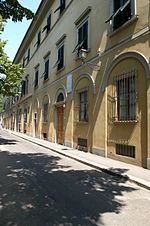Jewish Museum of Florence
Jewish museums in ItalyJews and Judaism in FlorenceMuseums established in 1981Museums in Florence

The Jewish Museum of Florence (Italian: Museo Ebraico di Firenze) is a museum of Jewish history located in the Great Synagogue of Florence, Italy. The museum, which covers two spaces of the building, gathers an important collection of ancient objects of Jewish ceremonial art, evidence of the high artistic level achieved by the Jewish-Italian communities in the field of applied arts. Exhibitions illustrate the history of Florentine Jews from the first settlements to the post-war reconstruction, featuring old photographs, films and a large number of objects of daily and commemorative use.
Excerpt from the Wikipedia article Jewish Museum of Florence (License: CC BY-SA 3.0, Authors, Images).Jewish Museum of Florence
Via Luigi Carlo Farini, Florence Quartiere 1
Geographical coordinates (GPS) Address External links Nearby Places Show on map
Geographical coordinates (GPS)
| Latitude | Longitude |
|---|---|
| N 43.77322 ° | E 11.26573 ° |
Address
Via Luigi Carlo Farini 6
50121 Florence, Quartiere 1
Tuscany, Italy
Open on Google Maps











